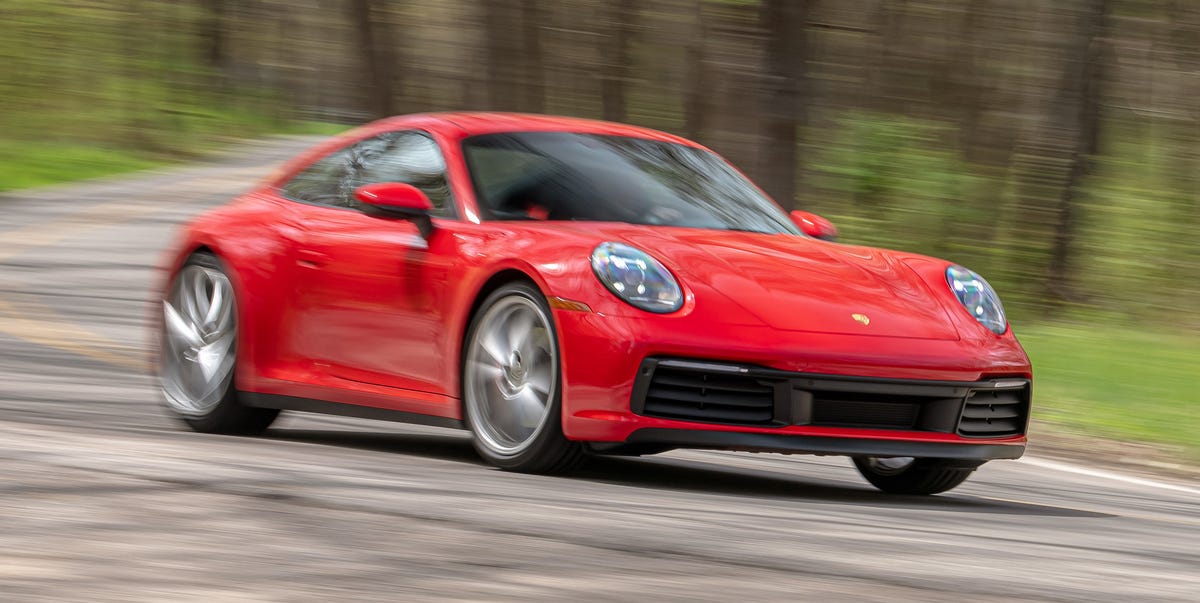
A decade ago, if someone had said that the highest-performing Ford Mustang and Chevrolet Corvette would not be available with a manual transmission but that a Porsche 911 Carrera S would, you’d get laughed out of the bar. We’re pretty sure that Porsche and Volkswagen Group executives from that era wouldn’t have taken that bet. The decline in the 911’s manual take rate really started with the 997 refresh that brought dual-clutch automatic transaxles (PDK in Porsche-speak) to the brand for the 2009 model year. Now, in its home market, only a single-digit percentage of 911 buyers opt to shift themselves. In the United States, it’s a different story. Roughly one in five 911 buyers go for the stick.
After driving the latest 911 generation with a manual transmission, you can count us as part of that 20 percent. The three-pedal 911 launched about a year after the first of the new 911s hit (the 992 generation), and we finally have our hands on one: the 443-hp 911 Carrera S. The seven-speed stick is a transaxle that Porsche, with the help of trans-supplier ZF, converted from dual-clutch auto to manual in part with a crafty mechanism called MECOSA. That acronym stands for mechanically converted shift actuator, and it makes the dual-clutch hardware work with a conventional shift pattern. Without it, you’d instinctively try to engage first gear and end up with third, maybe reverse. (It’s confusing, we know.) Imagine a Magic 8 Ball that returned a different shift pattern every time, and that’s about how confusing the non-MECOSA pattern would be.
The system works, which means the driver doesn’t perceive anything different, no weird sensations or anything special going on in the gearbox. The shifter feel isn’t muddled or murky. You just get a normal shifter. Well, at least as much normalcy as one can feel when there’s the rare ability to downshift to sixth. The Corvette team should really consider trying this approach to create a manual from its new Tremec dual-clutch automatic.
Despite this effort to keep three pedals—a very much appreciated effort, mind you—the manual version suffers a performance deficit that will likely drive some sales to the automatic. When the car isn’t moving, Porsche limits the revs to 3500 rpm to protect the trans and driveline from unnecessary abuse. A clutch dump at that engine speed results in a bog or a stall as the rear tires have a lot of traction. To extract a 3.6-second zero-to-60-mph time you must slip the clutch. And while that was also the case with the 991-generation 911s, in those you had an extra 500 revs to work with, which made it slightly easier to get right. Not helping matters are the 992’s larger diameter rear tires. An extra inch of overall diameter effectively lengthens the shape of the contact patch and increases longitudinal grip. That benefits braking, but it also increases launch traction.
Forget trying to keep pace with an automatic Carrera S (60 mph in 2.9 seconds). Even a base 379-hp Carrera, a car that you can’t yet get with the manual, will emphatically gap the manual-trans Carrera S from a green light. It isn’t until after the quarter mile, where the S’s 11.8-second run is 0.3 behind the base car, that the manual car’s superior power-to-weight ratio takes over. At 19.0 seconds of acceleration, the Carrera S hits 150 mph with the Carrera 1.5 seconds behind.
The manual has no effect on braking or cornering, though, with those taller Pirellis hauling down from 70 mph and 100 mph in 136 and 270 feet, respectively. The manual’s more-forceful-than-gravity 1.06 g on the skidpad is right in line with 911s these days.
Ordering a manual 911 doesn’t add to the cost of car, but that isn’t the same as saying “no cost” because Porsche used to charge $3200 for the automatic. As an olive branch, Porsche fits manual-equipped cars with a version of the Sport Chrono package that includes a dial on the steering wheel to change drive modes, dynamic powertrain mounts, a competition mode for the stability control, and a stopwatch dial on top of the dash. Manuals also come with automatic rev-matching downshifts, which is disabled in normal mode and when stability control is deactivated, and a mechanical limited-slip differential. Brake-based torque vectoring helps the car turn in corners, but we found no understeer in this car as it sticks and moves faster than Larry Holmes, in part due to being equipped with the 0.4-inch lower Sport Package ($3390) and the $2090 rear-axle steering. If we had a gripe, it’s that the high limits make sub-1.00-g cornering a little boring and almost too easy.
This 2020 911 started at $114,650 and, in addition to the sporting gear above, ventilated Sport Seats Plus and red seatbelts drove the final bill to $121,950. But the ordering books are already closed for 2020. The 2021 model will run you $1800 more to start, and that now includes standard keyless access, a $550 option for 2020 we’d gladly trade for the red belts.
If everyone on C/D‘s staff had the means to buy a 911, everyone would order a manual. It’s a little slower from a stop, but it is also much more enjoyable to have increased interaction with a car designed to bring joy to driving. However, then you start thinking about how wonderful Porsche’s dual-clutch is, and it is quicker. Hmm, forget it. Let’s just celebrate the manual while we still can.
This content is created and maintained by a third party, and imported onto this page to help users provide their email addresses. You may be able to find more information about this and similar content at piano.io
